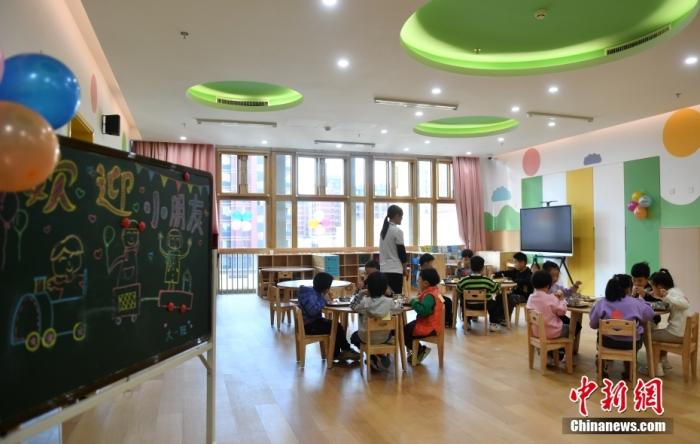China News Service, April 26th my country's implementation of the "three-child" birth policy, what challenges does it pose to the allocation of preschool education resources in the future?
In this regard, Lu Yugang, director of the Department of Basic Education of the Ministry of Education, said at the Ministry of Education's press conference on the 26th that the Ministry of Education will carefully predict the demand for admission, expand inclusive resources through multiple channels, and gradually resolve and eliminate "large class sizes". We will continue to expand inclusive preschool education resources, effectively meet the needs of school-age children to enter kindergartens, better serve the national population development strategy, and promote the implementation of the "three-child" policy.
Data map: Children in kindergarten are eating breakfast.
Photo by China News Agency reporter Han Bing
Lv Yugang said that the implementation of the national population development strategy and the implementation of the three-child birth policy are major strategic decisions made by the Party Central Committee and the State Council.
It is of great significance to implement the population strategy and fertility policy to run pre-school education well and realize the realization of early childhood education.
After ten years of rapid development, the popularization level of preschool education has been greatly improved. By last year, the gross enrollment rate of preschool three years had reached 88.1%. From this indicator, we can analyze that our preschool education has not yet achieved full popularization. There is a problem of large class sizes.
The total amount of preschool education resources, especially inclusive resources, is still insufficient.
With the implementation of the three-child policy, regional and structural resource conflicts will become more prominent, which is an important challenge for us.
Lv Yugang said that the Ministry of Education will follow the decisions and arrangements of the Party Central Committee and the State Council, take the implementation of the "14th Five-Year Plan" preschool education development and improvement plan as an important starting point, continue to expand inclusive preschool education resources, and effectively meet the needs of school-age children. , to better serve the national population development strategy and promote the implementation of the "three-child" policy.
One is to do a good job of forecasting the demand for admission.
With the adjustment of the fertility policy, it will inevitably have an impact on the birth changes of the population.
The Ministry of Education promotes localities to forecast the demand for admission year by year according to changes in the birth population, rural revitalization and urbanization, which is crucial to the allocation of resources.
At the same time, it is necessary to revise and improve the degree standards for population matching in residential areas in a timely manner.
The second is to expand inclusive resources through multiple channels.
The Ministry of Education will further consolidate the achievements that have been made in solving "difficulty in entering the kindergarten" and "expensiveness in entering the kindergarten", and make more efforts and efforts to further improve the level of inclusiveness.
Promote the improvement of the guarantee mechanism for inclusive preschool education based on the forecast of demand, focus on strengthening the construction of kindergartens in rural areas and urban areas with new population, build, renovate and expand a number of public kindergartens, and encourage and support state-owned enterprises and institutions, including The army, colleges and universities, streets, and rural collectives hold various types of public kindergartens, and actively support private kindergartens to provide inclusive preschool education services.
The third is to gradually resolve and eliminate the "large class size", that is, to meet the people's desire to "go to a good kindergarten" and achieve the goal of "children with good education".
The Ministry of Education actively promotes the resolution of large class sizes, and regards this as an important indicator for promoting universal and inclusive supervision and evaluation in counties, and promotes localities to gradually expand resources and adjust structures to reduce large class sizes, improve the conditions for running kindergartens, and improve the level of running kindergartens and the ability to maintain education. , and gradually realize the standardization of class sizes in kindergartens, creating conditions for better improving the level of scientific education.

